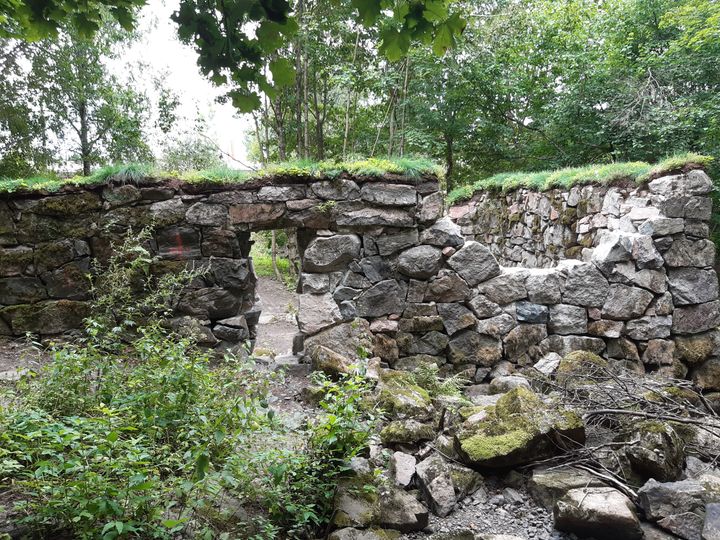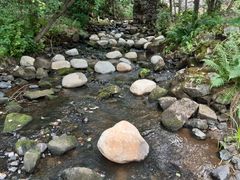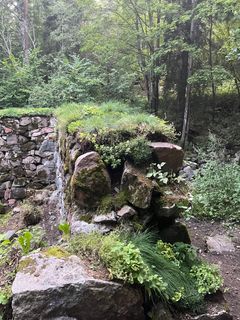Bemböle mill ruins and riverbed successfully restored
Forgotten for decades, the ruins of the Bemböle water mill have been restored. The riverbed was also restored, bringing it closer to its natural state in accordance with nature and conservation values. Completed in August, the magnificent end result of the restoration project is definitely worth a visit.

In the 18th century, there were two watermills - an upper and lower mill - on the Glomsinjoki rapids at Bemböle in Espoo. They stopped operating in 1929, when the wooden parts of the mill burned down in a fire. The remains of the wooden and stone mills in the original rapids environment include the ruins of the grey granite mill building, some dam and mill structures, downstream riverbed support structures and the mill pond behind the upper mill. In the now-completed project, the lower mill in the river was restored and the old cross country ski track bridge was dismantled. Water flow was restored over a span of approximately 60 metres.
Nationally protected mill ruins in a valuable nature area
Cereals from Bemböle, Karvasbacka, Gloms and Lövkulla were ground at the River Glomsinjoki rapids already at the end of the 16th century. A parish map from 1750 shows two watermills used during the spring and autumn floods. The old mills had already deteriorated at that time. They were replaced by a new vertical-axle mill, which was later replaced with a water wheel mill. In addition to the mill building, the watermill included a dam and a mill pond formed behind the dam.
The Bemböle mill ruins are protected by the Antiquities Act (295/1963), and they are listed as a nationally significant archaeological site (VARK). There are 12 such sites in Espoo. The Act prohibits the digging, covering, altering, damaging, removing and any other tampering of an archaeological site.
The mill ruins area is also protected by the Nature Conservation Act (1096/1996) as a priority habitat for specially protected species due to the Bembidion monticola ground beetle that is endemic to this area. The River Glomsinjoki stream valley is the only known habitat of Bembidion monticola in Finland. Nature and conservation values were taken into consideration in the restoration process. The restoration project was carried out in accordance with the instructions issued by experts of the ELY Centre and Finnish Environment Institute’s Coleoptera working group.
Successful restoration
The aim of restoring the mill ruins was to prevent their destruction, for example, by replacing missing keystones to support wall structures and employing old masonry techniques to relay and reinforce sections of the wall that had collapsed or were in danger of collapsing. The wall surface was protected with a layer of plaster and metal mesh, which was covered with a growth substrate and meadow matting. The purpose of the protective layer is to prevent water from entering the wall structures, thus preventing them from deteriorating in the future. The worst collapsed sections were relaid to prevent further collapse. The purpose of the restoration was not to restore the ruins, but to preserve them.
In connection with the restoration, water flow in the riverbed was restored under the direction of running water experts at the ELY Centre. During the restoration, stones were added to the riverbed to dam and guide the water, thus creating eddies where trout can rest and gather their strength on their migration upstream to Lake Bodominjärvi. The stones also offer shelter to trout fry.
The Public Works Department was responsible for the planning and funding of the restoration project. Espoo City Museum was responsible for the supervision of antiquities in planning. The project was carried out by IKJ Rakennus Oy, and it was completed according to plan, both on schedule and within the set budget. The magnificent end result of the restoration honours this site of historical significance.
More information:
Mikael Ahlfors
landscape horticulturist
Espoon kaupunki, kaupunkitekniikan keskus
mikael.ahlfors@espoo.fi
Tryggve Gestrin
curator
KAMU Espoo City Museum
0505666105
tryggve.gestrin@espoo.fi
Espoo has 12 nationally significant archaeological sites
Erityisesti suojeltavien lajien esiintymispaikan muuttaminen (in Finnish)
Bemböle kvarnar (In Swedish)
Images


Alternative languages
Subscribe to releases from Espoon kaupunki - Esbo stad
Subscribe to all the latest releases from Espoon kaupunki - Esbo stad by registering your e-mail address below. You can unsubscribe at any time.
Latest releases from Espoon kaupunki - Esbo stad
Sellosalin syksyssä huippunimiä ja harvinaisuuksia maailmalta13.10.2025 08:00:00 EEST | Tiedote
Sellosalin lavalla saadaan syksyn aikana nauttia monista huikeista artisteista ympäri maailmaa. Maailmanmusiikin isot nimet, The Klezmatics (US) ja Söndörgő (HU) tuovat kiertueensa Espoon Leppävaaraan loka- ja marraskuussa.
Tilastot ja tutkimukset -kuukausitiedote lokakuu 202510.10.2025 12:25:33 EEST | Tiedote
Espoon uusi vuoden 2025 pitkän ajan väestöennuste: Väestö 2024 ja ennuste 2025–2060. Espoon väkiluku oli elokuun 2025 lopussa ennakkotietojen mukaan 324 840. Etenkin pitkäaikaistyöttömyys kasvanut voimakkaasti.
Espoon uusi Kiviruukin lukio keskeinen toimija uudessa oppimisen keskuksessa Cleantech Gardenissa9.10.2025 10:06:41 EEST | Tiedote
Espoon uusin lukio tulee olemaan Kiviruukin lukio, joka aloittaa toimintansa syksyllä 2027. Se on osa uutta Kiviruukkiin rakentuvaa oppimisen keskusta Cleantech Gardenia. Lukiossa tulee olemaan noin 370 aloituspaikkaa. Englanninkieliselle linjalle on haettu järjestämislupaa.
Flygekorrprojektet tar slut, men Esbo samordnar även i fortsättningen byggande och skydd av flygekorren9.10.2025 08:23:50 EEST | Pressmeddelande
Det stora internationellt projektet för skydd av flygekorren fullbordas. Inom projektet skaffade staden nya fakta om flygekorrens levnadsvanor och om planläggning som tar hänsyn till flygekorren. Det visade sig att flygekorren klarar sig i staden bättre än väntat.
Liito-orava-LIFE-hanke päättyy – Espoo sovittaa jatkossakin yhteen kaupunkikehityksen ja liito-oravien suojelun9.10.2025 08:23:50 EEST | Tiedote
Juuri päättynyt suuri kansainvälinen liito-oravien suojeluhanke toi Espooseen uutta tietoa liito-oravien elintavoista sekä kaavoitusratkaisuista. Hanke osoitti, että liito-oravat pärjäävät kaupungissa luultua paremmin.
In our pressroom you can read all our latest releases, find our press contacts, images, documents and other relevant information about us.
Visit our pressroom